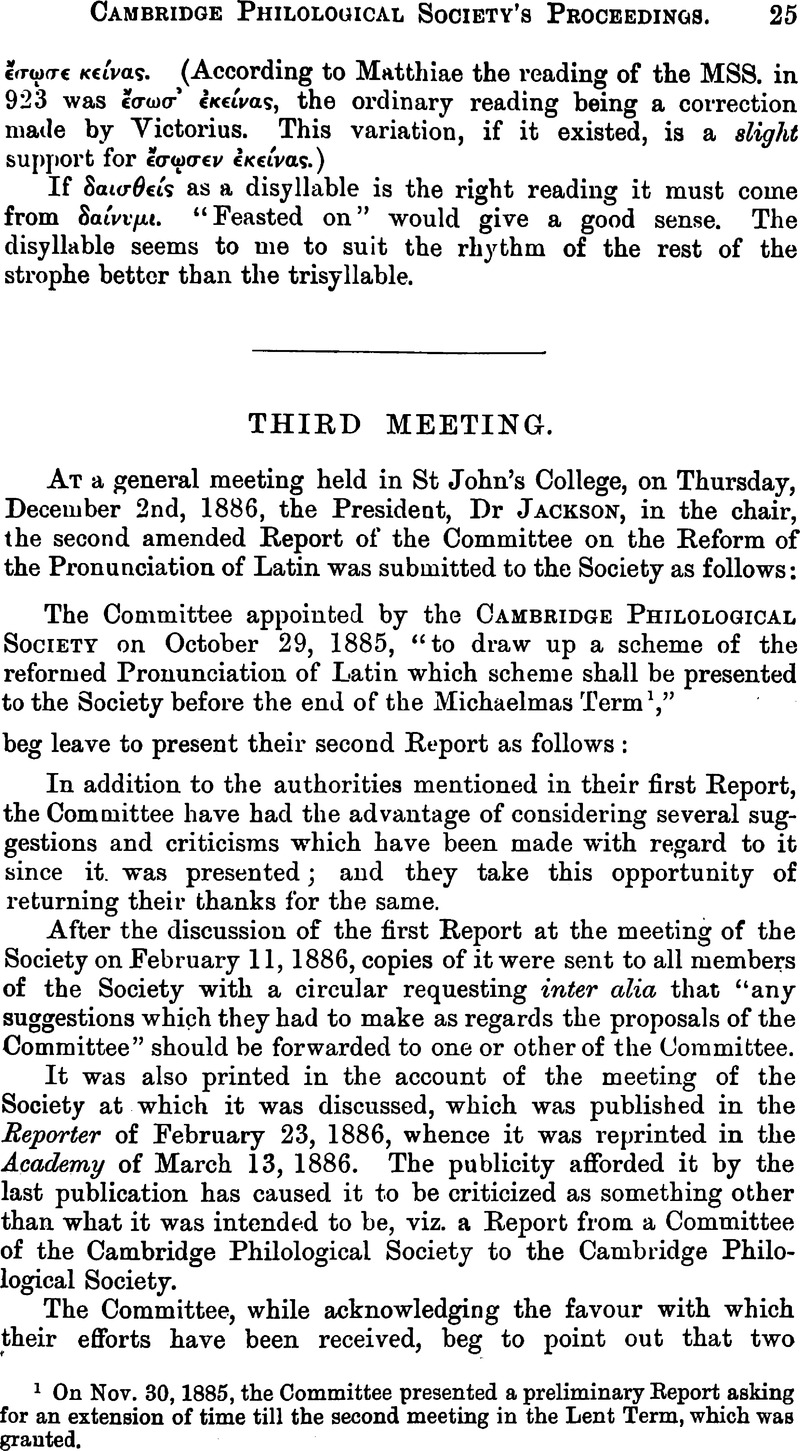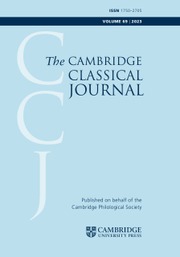No CrossRef data available.
Article contents
Third Meeting
Published online by Cambridge University Press: 02 April 2015
Abstract

- Type
- Michaelmas Term, 1886
- Information
- Proceedings of the Cambridge Philological Society (First Series) , Volume 13 , January 1886 , pp. 25 - 33
- Copyright
- Copyright © The Author(s). Published by Cambridge University Press 1886
References
page 25 note 1 On Nov. 30, 1885, the Committee presnted a preliminary Report asking for an extension of time till the second meeting in the Lent Term, which was granted.
page 26 note 1 The difference between close and open vowels (otherwise called ‘narrow” and ‘wide’) is caused by drawing up the part of the tongue with which the sound is produced and thus making it more convex than it is in its natural relaxed position (open). This making a ‘narrow’ of the passage of the sound, whence the name.
page 27 note 1 Lat. final ĭ seems to have had an intermediate sound between ě and ĭ as in herĭ, yesterday, written in Quintilian's time herě. Q. says, Inst. I. 4, 8Google Scholar, in here neque e plane neque i auditur; compare I. 7, 22, 24. This is supported by the various spellings on inscriptions sibi, sibe, sibei ; quasi, quase, quasei, so with tibi, ubi. The sound was probably that of Eng. final y as in lady.
page 27 note 2 Modified u (ü) has two sounds in (North) German: (a) when long, it is close as in grün, güte; so in Fr. lune, aigu: (b) when short, it is open as in hütte, schützen. These sounds may be produced approximately by pronouncing ī as in machīne and ĭ as in fĭt respectively, with rounded lips.
page 27 note 3 The pronunciation of the Latin o seems to have fluctuated, ō (which is generally, although not always close) was sometimes nearer to the Eng. aw in law but more often to the Fr. au (with a higher position of the tongue) while the short open o is sometimes nearer to the Eng. o in not but more often to the N. Ger. o in stŏck. Generally speaking Latin ē and ō are Italian close e and o, while Latin ŏ and Ě are Italian open o and e.
page 28 note 1 AE was not far from the Ger. ä and had a tendency to become open e (as in men, sped): but it was not till the 6th cent. A.D. that ae and e became quite confused. AU is the German au in haus. The nearest sound in Eng. is ou in house, which should be pronounced ‘broadly’ haouse. EI is the Eng. diphthong in grey (rain, mate etc.). EU as in It. neutro. UI as in It. colui.
The old Latin diphthongs AI, pronounced as Greek at (as in Eng. Isaiah, broadly pronounced), and OI, as oi in loin, had disappeared before the Augustan period.
page 28 notw 2 Lat. gn after a vowel has been supposed to have the sound of ng-n, rēgnum being pronounced rēng-num, cōgnōmen as cōng-nomen. MrRoby, (Lat. Gr. I. Pref. p. 79 sqq.Google Scholar) and Seelmann, (Aussprache des Lateins pp. 274, 278Google Scholar) doubt this.
page 28 note 3 But the tongue should touch the teeth instead of the forepart of the palate.
page 29 note 1 ‘Voiced’ sounds are produced with, ‘voiceless’ without vibrations of the vocal chords; b, d, g, z (in zest) are voiced, p, t, k, s are voiceless. The ‘voiced’ s (z) has been sometimes assumed for classical Latin in certain words when the s stands between two vowels, e.g. rosa; but without sufficient authority. It was, however, probably heard in borrowed Greek words like Smyrna, smaragdus (often written Zmyrna, zmaragdus). The voiced s of Old Latin had become r; as in laborem, Old Latin labosem.—S, like T, D, N, L, is a pure dental produced by putting the tongue near the teeth at a point more forward than in the Eng. s.—For pronunciation of ns preceded by a vowel see note 2 inf.
page 29 note 2 The pronunciation of final m is not free from doubt. It is clear that it was more weakly sounded than at the beginning or in the middle of a word. (1) When a consonant followed it, the m must have remained consonantal as the vowel which preceded was lengthened in position. Thus turn tenet, tum canet were scanned (2) Before a vowel, however, or before h followed by a vowel, both the m and the preceding vowel were disregarded in scansion, montem habet being scanned–just like mons habet or monte habet. In (1) the m was probably assimilated to the following consonant becoming ng before ‘gutturals’, mensam grauem being pronounced mensanggrauem (cf. quamquam or quanquam pronounced quangquam), n before t, d, n, s, i consonant, mensam tenet being pronounced mensantenet (and quom iam quowiam). Before r, l it was completely assimilated, mensam leuem being mensalleuem, mensam rudem mensarrudem. In (2) the final m was probably-absorbed into the preceding vowel which was nasalized. Thus, adopting the customary mark for a nasal vowel, -am became ā, -em ē etc. The nasalized vowel thus formed was slurred on to the following vowel like any non-nasalized vowel. Thus fluctum accipit was pronounced fluct¯uaccipit, quanquam incipit as quanquāincipit etc. [Nasal vowels are produced by sending the voice in part through the nose. The French vowels in en, on, un, vin etc. are familiar examples of nasal vowels.]
Mr A. J. Ellis however believes that the m was always omitted in speaking and the following consonant pronounced as if it were doubled: quorum pars he would pronounce quoruppars, spargam flores as spargafflores, animamque as animacque. Final im followed by i consonant he pronounces as ī, -um followed by u consonant as ü: e.g. clauim iacit as clauī iacit. Final m at the end of a sentence he thinks was not heard at all. Where a vowel followed as in (2) he believes that the m was never sounded and that fluctum was treated exactly like fluctu, mensam like mensa, the final vowel before m being simply slurred on to the following one.
It is also possible that a vowel was nasalized when it was immediately followed by ns. This would explain the frequent omission of the n in such cases, cesor appearing on inscriptions by censor, cosol by consul etc. In this case īnsanus (see below) would be pronounced ![]() eesānus, frūns (for frōns, frondis), also written frūs (Ennius), fr
eesānus, frūns (for frōns, frondis), also written frūs (Ennius), fr![]() ss.
ss.
page 29 note 3 In a number of cases the i was pronounced twice though only written once. So in obicio, pronounced obyikio.
page 29 note 4 It may however have been pronounced as Fr. ou in oui.
page 30 note 1 The proper rolling of the r is most important, especially at the end of words, the English tendency being to slur all unaccented finals. Thus we pronounce er, ir, ur without any distinction with the same single vowel, and assimilate them all to the final short a, and consequently make no difference in sound between mater, (a)mattur and (a)mata. So leuir is pronounced ‘lever.’ In reading verse this destroys the metre by producing hiatus: flatur erit is pronounced as if it were flata erit. So also in other cases: uěr, cūr and uĭr are all pronounced alike with the same vowel sound and no rr; they should be sounded wēhrr, koorr, and wĭrr. The mis-pronunciation is not confined to finals; arbor is pronounced ‘ahbor’ (or even ‘ahba’) in place of ăhrrbŏrr; uertit ought to be pronounced wěrrtit.
page 30 note 2 These sounds are heard in Ireland. They may be obtained by pronouncing ink-horn, pot-house, tap-house so that the mute comes into the second syllable, in-khorn, po-thouse, ta-phouse. It is quite incorrect to pronounce th as in thin, and ph as f.
page 31 note 1 This is what Cicero means by coniungere uocales, Orator § 150.
page 32 note 1 The natural length of a vowel must be distinguished from the conventional ‘lengthening’ which it is said to undergo before two consonants. In indoctusthe i is itself short, but the fact that nd follow allows the syllable to be treated in verse as if it were naturally long as in ī-bat. In insanus the vowel itself is long, ![]() . What vowels were naturally long and short, cannot be completely determined. But we learn from ancient authorities that vowels were long before the combinations ns, nf, thus: cōnstāns, īnfēnsus: so also before gn: rēgnum, sīgnum and at least sometimes before nc, nq: quīnque, Quīn(c)tus, sānctus. Where a g became c before t, s etc., the preceding vowel became long as in lēctus from lěgo, while from sěco we have sěctus. The vowel is frequently long before r and a consonant: Mārcus (Maarcus), Mārs, ōrdo, ōrno. The natural quantity of the vowel was retained when two consonants followed, as in scrīptus from scrībo. See Seelmann, Aussprache des Lateins pp. 69Google Scholar sqq., Marx Hülfsbüchlein für die Aussprache der Lat. Vokale in positionslangen Silben.
. What vowels were naturally long and short, cannot be completely determined. But we learn from ancient authorities that vowels were long before the combinations ns, nf, thus: cōnstāns, īnfēnsus: so also before gn: rēgnum, sīgnum and at least sometimes before nc, nq: quīnque, Quīn(c)tus, sānctus. Where a g became c before t, s etc., the preceding vowel became long as in lēctus from lěgo, while from sěco we have sěctus. The vowel is frequently long before r and a consonant: Mārcus (Maarcus), Mārs, ōrdo, ōrno. The natural quantity of the vowel was retained when two consonants followed, as in scrīptus from scrībo. See Seelmann, Aussprache des Lateins pp. 69Google Scholar sqq., Marx Hülfsbüchlein für die Aussprache der Lat. Vokale in positionslangen Silben.




